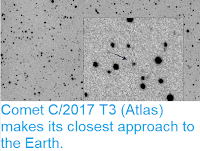Comet C/2018 N2 (ASASSN) will make its closest approach to the Earth on Sunday 20 October 2019, reaching a distance of 2.11
AU from the Earth (211%
of the distance between the Earth and the Sun, or 330 880 000 km). At
this distance the comet will be not naked eye visible, having a
magnitude of slightly over 12, requiring a reasonably good telescope to
see it, in the Constellation of Andromeda, which is better observed from the
Northern Hemisphere, and viewing will be poor the approach comes seven days after the Full Moon on Sunday 13 October, so that the
meteors may be obscured by the brightness of the Moon.
Image of C/2018 N2 (ASASSN) taken from Denver, Colorado, on 30 December 2018. The image is a composite of six 300 second exposures. The comet is the point near the centre of the image marked N2, the slightly elongate objects in the background are stars which have moved over the time of the exposure. Mike Olason/Sky & Telescope.
C/2018 N2 (ASASSN) was first observed on 16 July 2019 by the the 14-cm 'Cassius' survey telescope at Cerro Tololo as part of the All-Sky Automated Survey for Supernovae (ASASSN) program.. The name C/2018 N2 (ASASSN) implies that it was the second comet discovered in the second half of July 2018 (Period 2018 N), and that it was discovered by the All-Sky Automated Survey for Supernovae.
The orbit and position of Comet C/2018 N2 (ASASSN) at its closest approach to the Earth. The Sky Live 3D Solar System Simulator.
C/2018 N2 (ASASSN) is a Parabolic Comet, which is to say a comet that has been disrupted from an orbit in the Oort Cloud, and to be passing through the Inner Solar System on a parabolic orbit that will probably not bring it back again. This parabolic trajectory tilted at an angle of 77.5° to the plain of the Solar System, that brought it in to 3.12 AU from the Sun at perihelion (i.e. 3.12 times as far from the Sun as the planet Earth, or more than twice as far from the Sun as the planet Mars).
See also...
Follow Sciency Thoughts on Facebook.








